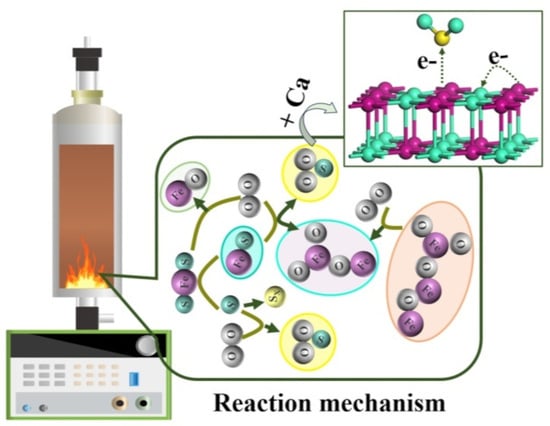Study on the Migration and Release of Sulfur during the Oxidizing Roasting of High-Sulfur Iron Ore
Abstract
1. Introduction
2. Materials and Methods
2.1. Material
2.2. Experimental System
2.3. DFT Computation
3. Results
3.1. Release Characteristics of Sulfur under Different Roasting Conditions
3.2. Mechanism of Sulfur Element Release
3.3. Effect of Sulfur Fixative CaO on the Release of Sulfate and Mechanism Analysis
4. Discussion
4.1. Release Characteristics of Sulfur under Different Roasting Conditions
4.1.1. Effect of the SO2 Release on the Mass Concentration of Sulfur Element
4.1.2. Effect of the S-Release on the Different Roasting Temperatures
4.1.3. Effect of the SO2 Release on the Concentration of Oxygen
4.1.4. Effect of the SO2 Release under Air Atmosphere
4.2. Mechanism of Sulfur Element Release
4.3. Effect of Sulfur Fixative CaO on the Release of Sulfate
5. Conclusions
Author Contributions
Funding
Data Availability Statement
Conflicts of Interest
References
- Chen, X.J.; Wang, Y.Y.; Hu, X.M. Novel strategy of using a C/C electrodes electro-activated peroxymonosulfate to remove NO from simulated flue gas. Sep. Purif. Technol. 2021, 257, 117859. [Google Scholar] [CrossRef]
- Galina, N.R.; Romero Luna, C.M.; Arce, G.L.A.F.; Ávila, I. Comparative study on combustion and oxy-fuel combustion environments using mixtures of coal with sugarcane bagasse and biomass sorghum bagasse by the thermogravimetric analysis. J. Energy Inst. 2019, 92, 741–754. [Google Scholar] [CrossRef]
- John, J.; Evans, C.; Johnson, B. Nitric acid treatment of a pyrite rougher concentrate to oxidise differentially the pyrite types and modify the Au:S ratio in a resulting cleaner concentrate. Miner. Eng. 2023, 202, 108270. [Google Scholar] [CrossRef]
- Yang, J.; Zhou, X. Rb-Sr, Sm-Nd, and Pb isotope systematics of pyrite: Implications for the age genesis of lode gold deposits. Geology 2001, 29, 711–714. [Google Scholar] [CrossRef]
- Dyni, J.R. Geology and Resources of Some World Oil-Shale Deposits; US Geological Survey: Reston, VA, USA, 2006; pp. 68–72.
- Lin, S.D.; Gao, L.; Yang, Y.; Chen, J. Dielectric properties and high temperature thermochemical properties of the pyrolusite-pyrite mixture during reduction roasting. J. Mater. Res. Technol. 2020, 9, 13128–13136. [Google Scholar] [CrossRef]
- Song, W.; Zhou, J.; Wang, B.; Li, S.; Han, J. New insight into investigation of reduction of desulfurization ash by pyrite for clean generation SO2. J. Clean. Prod. 2020, 253, 120026. [Google Scholar] [CrossRef]
- Zhang, W.; Wang, H.M.; Ma, Y.C.; You, C.F. Sulfur fixation for raw coal with combined microwave irradiation and ultrafine Ca(OH)2 method. Fuel 2022, 330, 125570. [Google Scholar] [CrossRef]
- Makgato, S.S.; Chirwa, E.M.N. Recent developments in reduction of sulfur emissions from selected Waterberg coal samples used in South African power plants. J. Clean. Prod. 2020, 276, 123192. [Google Scholar] [CrossRef]
- Wang, T.; Zhang, H.; Yang, H.; Lv, J. Oxidation mechanism of pyrite concentrates (PCs) under typical circulating fluidized bed (CFB)roasting condition sanded sign principles of PCs’CFB roaster. Chem. Eng. Process. Process Intensif. 2020, 153, 107944. [Google Scholar] [CrossRef]
- MEE (Ministry of Ecology and Environment of People’s Republic of China). Guideline on Available Technologies of Pollution Prevention and Control for Thermal Power Plant; Ministry of Ecology and Environment of People’s Republic of China: Beijing, China, 2017. (In Chinese)
- NDRC (National Development and Reform Commission of People’s Republic of China). Upgrade and Retroft Plan for Coal-Fired Power Plants Aiming at Energy Savings and Emissions Reduction for 2014–2020; National Development and Reform Commission of People’s Republic of China: Beijing, China, 2014. (In Chinese)
- Paula, L.A.; Javier, G.G.; Fernando, G. Chemistry and phase evolution during roasting of toxic thallium-bearing pyrite. Chemosphere 2017, 181, 447–460. [Google Scholar]
- Yu, Y.; Li, L.; Wang, J.Y.; Li, K.Z.; Wang, H. Phase transformation of Sn in tin-bearing iron concentrates by roasting with FeS2 in CO-CO2 mixed gases and its effect son Sn separation. J. Alloys Compd. 2018, 750, 8–16. [Google Scholar] [CrossRef]
- Zhang, K.; Ge, Y.; Guo, W.C.; Li, N.; Wang, Z.F. Phase transition and magnetic properties of low-grade limonite during reductive roasting. Vacuum 2019, 167, 163–174. [Google Scholar] [CrossRef]
- Zhang, B.; Zhu, G.; Lv, B. A novel high-sulfur fine coal clean desulfurization pretreatment: Microwave magnetic separation, high-gradient effect and magnetic strengthen. J. Clean. Prod. 2018, 202, 697–709. [Google Scholar] [CrossRef]
- Zhang, B.; Zhao, Y.; Zhou, C. Fine coal desulfurization by magnetic separation and the behavior of sulfur component response in microwave energy pretreatment. Energy Fuels 2015, 29, 1243–1248. [Google Scholar] [CrossRef]
- Wang, Y.; Yang, H.; Jing, B. Comprehensive recovery of lead, zinc, and iron from hazardous jarosite residues using direct reduction followed by magnetic separation. Int. J. Miner. Metall. Mater. 2018, 25, 123–130. [Google Scholar] [CrossRef]
- Wang, Y.; Yang, H.; Zhang, W. Study on recovery of lead, zinc, and iron from jarosite residues and simultaneous sulfur fixation by direct reduction. Physicochem. Probl. Miner. Process. 2018, 54, 517–526. [Google Scholar]
- Thauan, G.; da Rafael, R.; Maykon, C. Pyrite roasting in modified fluidized bed: Experimental and modeling analysis. Chem. Eng. Sci. 2022, 261, 117977. [Google Scholar]
- Tosun, Y.I. Clean fuel-magnesia bonded coal briquetting. Fuel Process. Technol. 2007, 88, 977–981. [Google Scholar] [CrossRef]
- Li, J.; Fan, B.G.; Huo, R.P. Study on quenching hydration reaction kinetics and desulfurization characteristics of magnesium slag. J. Clean. Prod. 2018, 190, 12–23. [Google Scholar]
- Luo, C.; Zheng, Y.; Xu, Y. Wet mixing combustion synthesis of CaO-based sorbents for high temperature cyclic CO2 capture. Chem. Eng. J. 2015, 267, 111–116. [Google Scholar] [CrossRef]
- Zhang, D.K. Interactions between sodium, silica and sulfur in a low-rank coal during temperature-programmed pyrolysis. J. Fuel Chem. Technol. 2005, 33, 513–519. [Google Scholar]
- Wang, S.; Fan, S.; Fan, L. Effect of cerium oxide doping on the performance of CaO-based sorbents during calcium looping cycle. Environ. Sci. Technol. 2015, 49, 5021–5027. [Google Scholar] [CrossRef]
- Pan, F.; Ji, H.; Du, P.; Huang, T.; Wang, C.; Liu, W. Insights into catalytic activation of peroxymonosulfate for carbamazepine degradation by MnO2 nanoparticles in-situ anchored titanate nanotubes: Mechanism, ecotoxicity and DFT study. J. Hazard. Mater. 2021, 402, 123779. [Google Scholar] [CrossRef]
- Ma, M.; Chen, L.; Zhao, J.; Liu, W.; Ji, H. Efficient activation of peroxymonosulfate by hollow cobalt hydroxide for degradation of ibuprofen and theoretical study. Chin. Chem. Lett. 2019, 30, 2191–2195. [Google Scholar] [CrossRef]
- Li, X.R.; Yan, P.W.; Li, L.N.; Chen, Y.; Chen, Z.L. Activation of peroxymonosulfate by natural pyrite for effective degradation of 2,4,6-trichlorophenol in water: Efficiency, degradation mechanism and toxicity evaluation. Sep. Purif. Technol. 2023, 322, 124253. [Google Scholar] [CrossRef]
- Zhang, Y.; Hu, J.M.; Cao, Q.Z. Density functional theory studies on the adsorption of CO2 on different CaO surfaces. Chin. J. Struct. Chem. 2013, 32, 1715–1723. [Google Scholar]
- Feng, Z.Y.; Chen, N.; Liu, T.; Feng, C.P. KHCO3 activated biochar supporting MgO for Pb (II) and Cd(II) adsorption 3 from water: Experimental study and DFT calculation analysis. J. Hazard. Mater. 2022, 426, 128059. [Google Scholar] [CrossRef]
- Wang, T.; Zhang, H.; Liu, Q.; Yang, H. Experimental studies on phase transformation during pyrite concentrate oxidation under circulating fluidized bed (CFB) roasting conditions. Ind. Eng. Chem. Res. 2011, 50, 14168–14174. [Google Scholar] [CrossRef]
- Panneerselvam, M.; Rao, K. Novel microwave method for the synthesis and sintering of mullite from kaolinite. Chem. Mater. 2003, 15, 2247–2252. [Google Scholar] [CrossRef]
- Ebadzadeh, T. Effect of mechanical activation and microwave heating on synthesis and sintering of nano-structured mullite. J. Alloys Compd. 2010, 489, 125–129. [Google Scholar] [CrossRef]
- Arnold, R.G. Mixtures of hexagonal and monoclinic pyrrhotite and the measurement of the metal content of pyrrhotite by X-ray diffraction. Am. Mineral. 1966, 51, 1221–1227. [Google Scholar]
- Wu, J.; Yu, D.; Zeng, X.; Yu, X. Impacts of CO2 on the pyrite–kaolinite interaction and the product sintering strength, Proceedings of the Combustion Institute. Proc. Combust. Inst. 2019, 37, 4479–4486. [Google Scholar] [CrossRef]
- Srinivasachar, S.; Boni, A.A. A kinetic model for pyrite transformations in a combustion environment. Fuel 1989, 68, 829–836. [Google Scholar] [CrossRef]
- Yu, D.; Zhao, L.; Zhang, Z. Iron transformation and ash fusibility during coal combustion in air and O2/CO2 medium. Energy Fuels 2012, 26, 3150–3155. [Google Scholar] [CrossRef]
- Li, Y.; Gupta, R.; Wall, T. Fragmentation behavior of pyrite and calcite during high-temperature processing and mathematical simulation. Energy Fuels 2001, 15, 389–394. [Google Scholar]
- Hu, G.; Dam-Johansen, K.; Wedel, S.; Hansen, J.P. Decomposition and oxidation of pyrite. Prog. Energy Combust. Sci. 2006, 32, 295–314. [Google Scholar] [CrossRef]
- Sydorovych, Y.Y.E.; Gaivanovych, V.; Martynets, E. Desulfurization of Donetsk Basin coals by air-steam mixture. Fuel 1996, 75, 78–80. [Google Scholar] [CrossRef]
- Pysh’yev, S.; Shevchuk, K.; Chmielarz, L. Effect of the water-vapor content on the oxidation desulfurization of sulfur-rich coal. Energy Fuels 2007, 21, 216–221. [Google Scholar] [CrossRef]
- Pysh’Yev, S.; Gunka, V. Study of the oxidation desulfurization process of coal with different metamorphism degrees. J. Fuel Chem. Technol. 2012, 40, 129–137. [Google Scholar] [CrossRef]
- Peng, Z.W.; Mourisj, H. Microwave Absorption characteristics of conventionally heated nonstoichiometric ferrous oxide. Metall. Land Mater. Trans. A 2001, 42, 2259–2263. [Google Scholar] [CrossRef]
- Duo, W.; Laursen, K.; Lim, J. Crystallization and fracture: Product layer diffusion in sulfation of calcined limestone. Ind. Eng. Chem. Res. 2004, 43, 5653–5662. [Google Scholar] [CrossRef]
- Laursen, K.; Duo, W.; Grace, J.R. Sulfation and reactivation characteristics of nine limestones. Fuel 2000, 79, 153–163. [Google Scholar] [CrossRef]
- Wang, W.J.; Fan, L.L.; Wang, G.P.; Li, Y.H. CO2 and SO2 sorption on the alkali metals doped CaO (100) surface: A DFT-D study. Appl. Surf. Sci. 2017, 425, 972–977. [Google Scholar] [CrossRef]
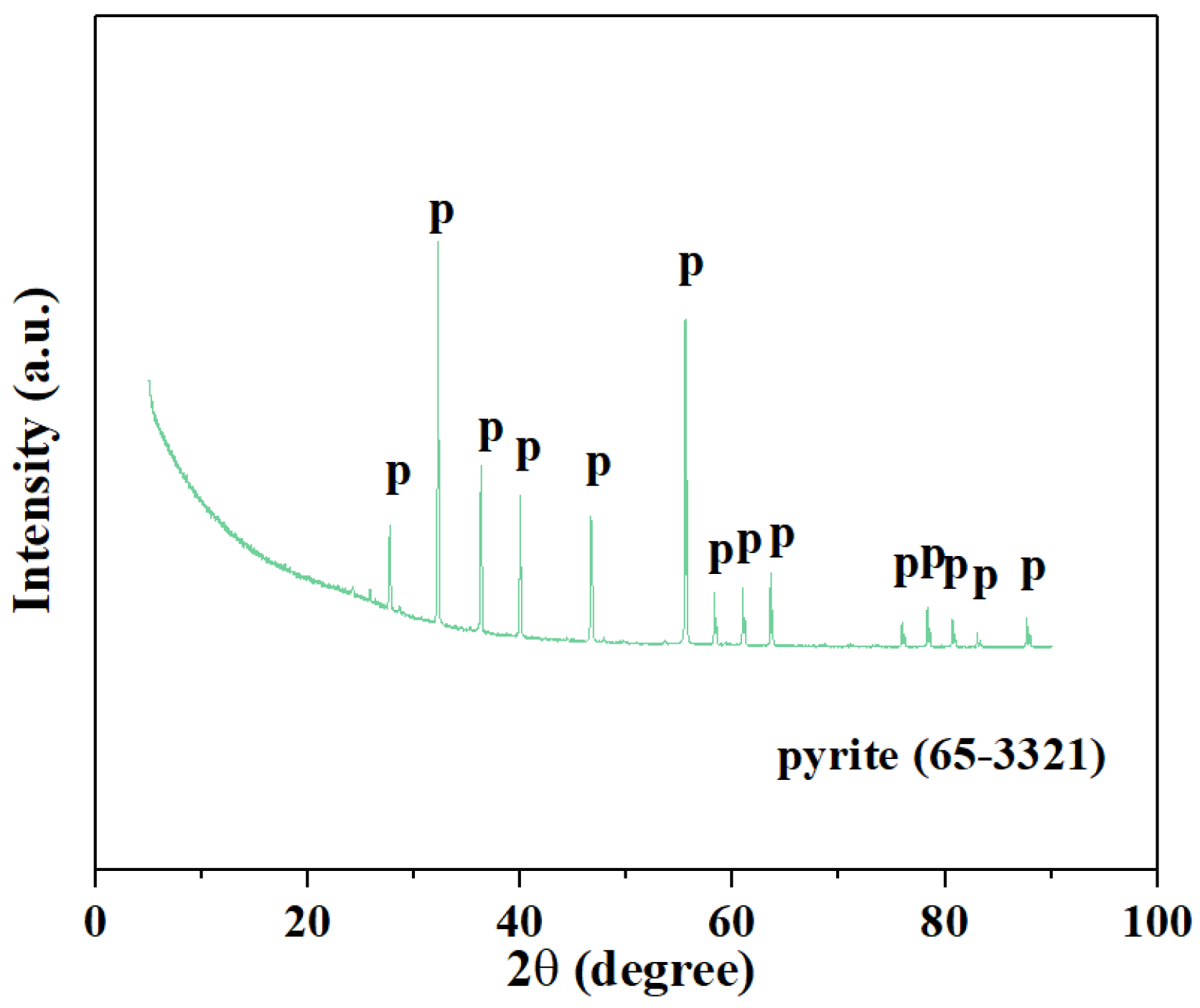
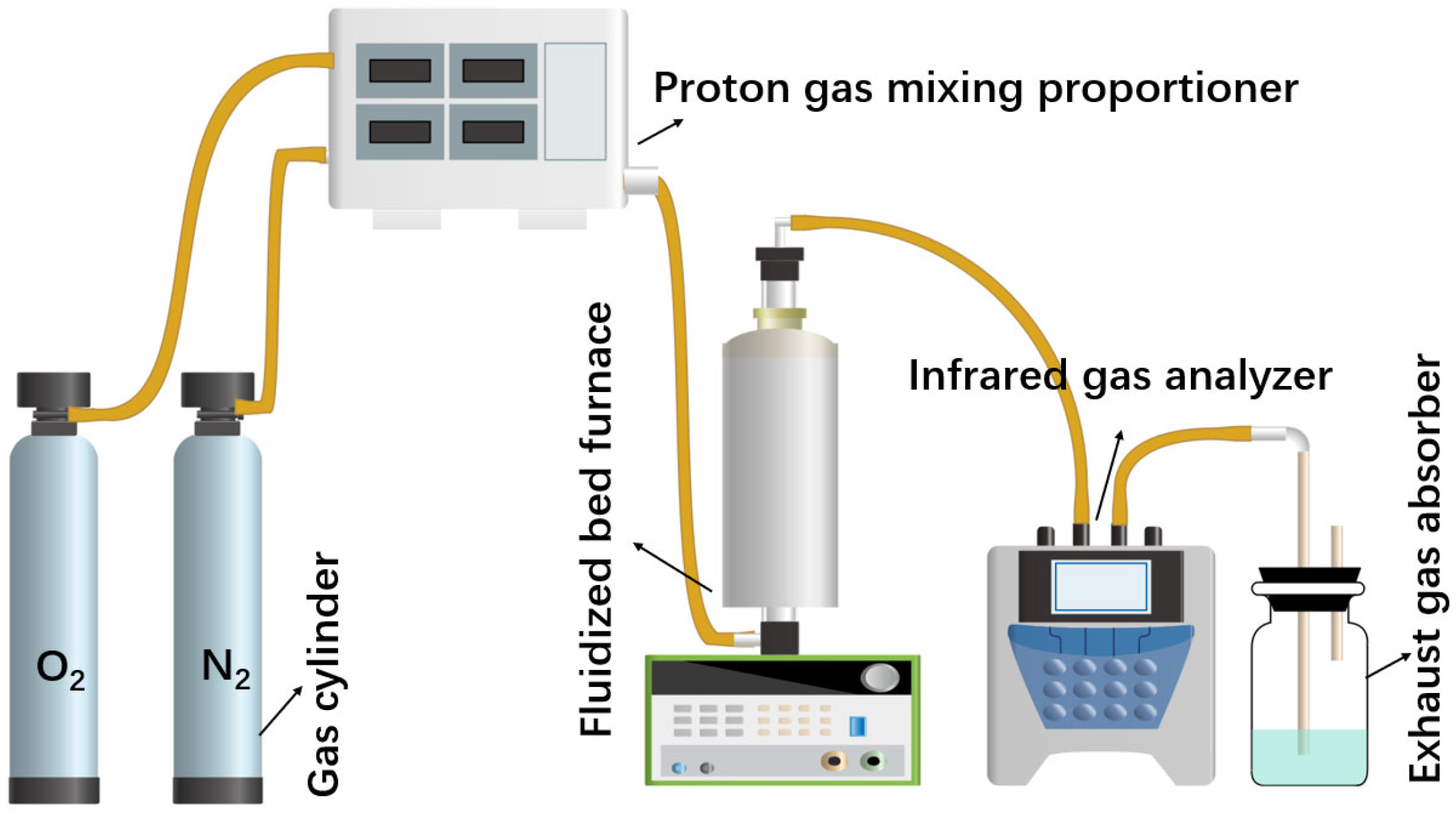
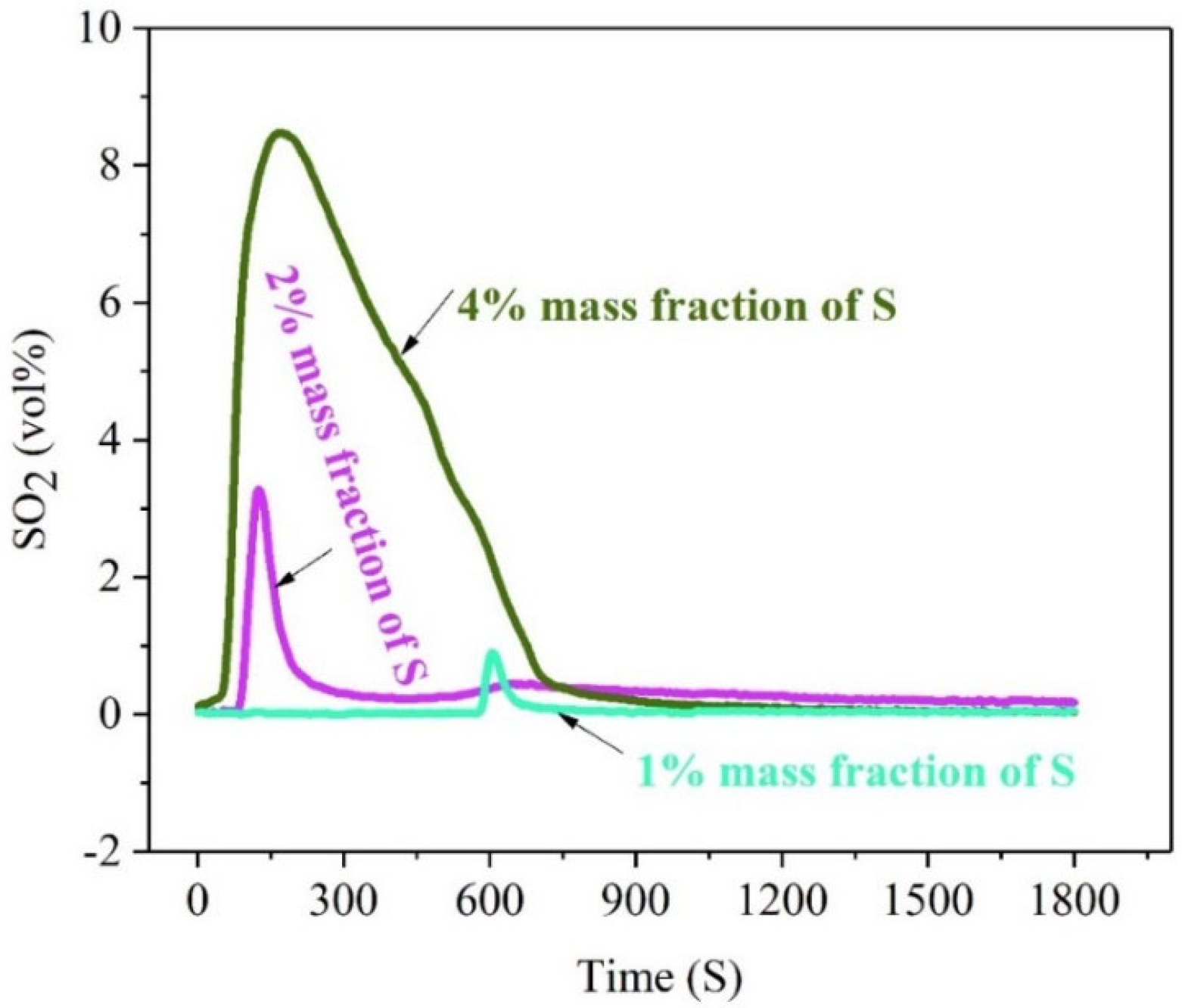
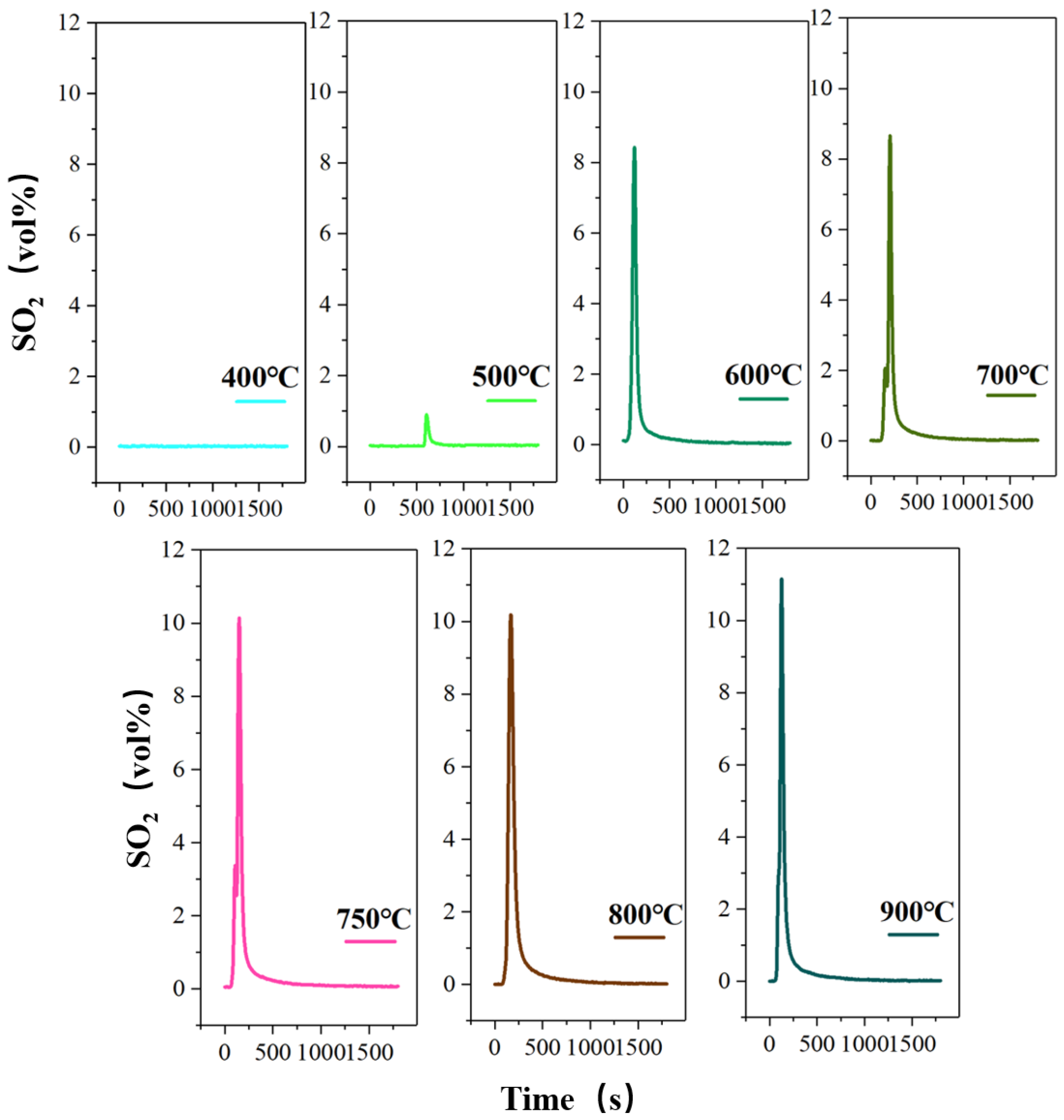
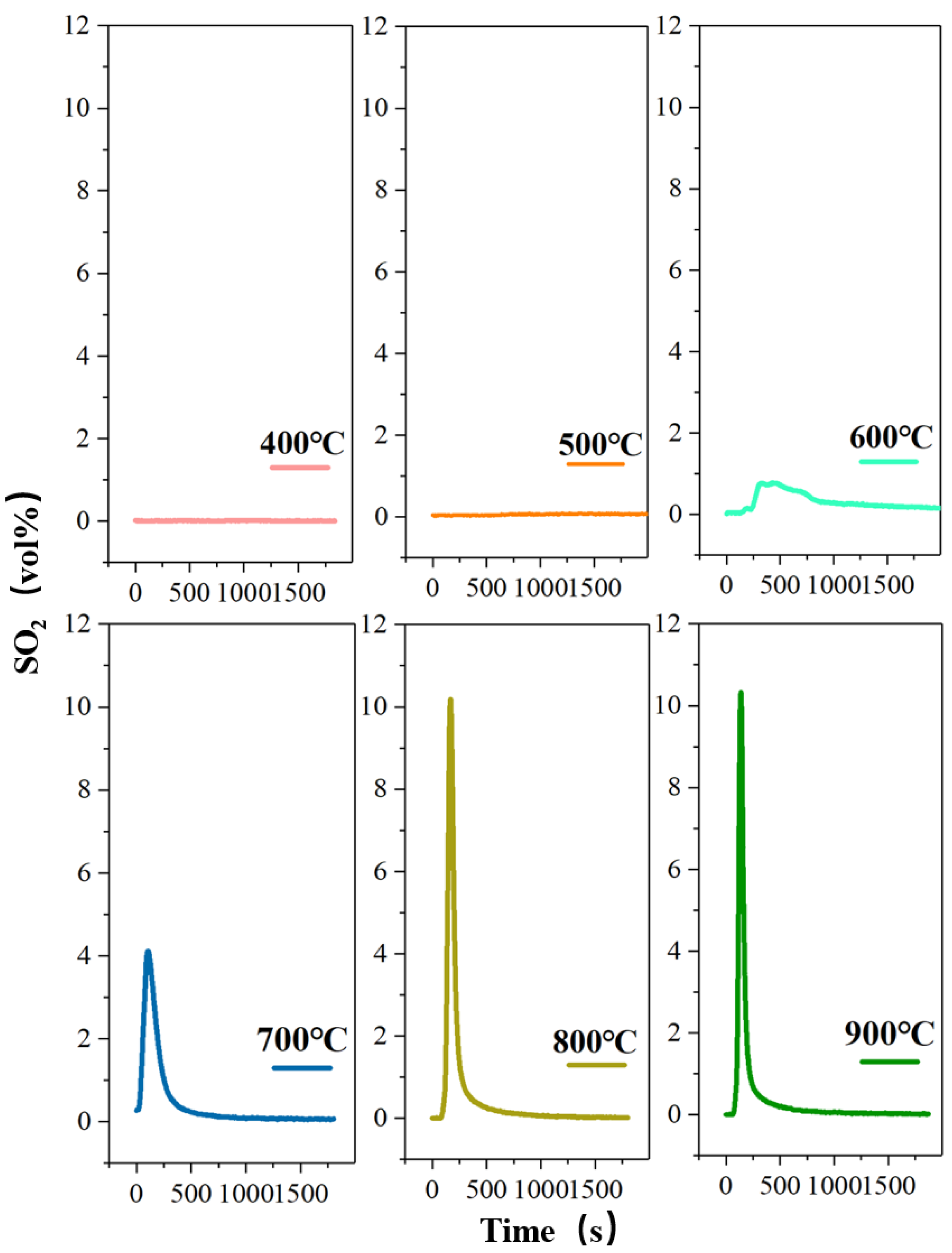
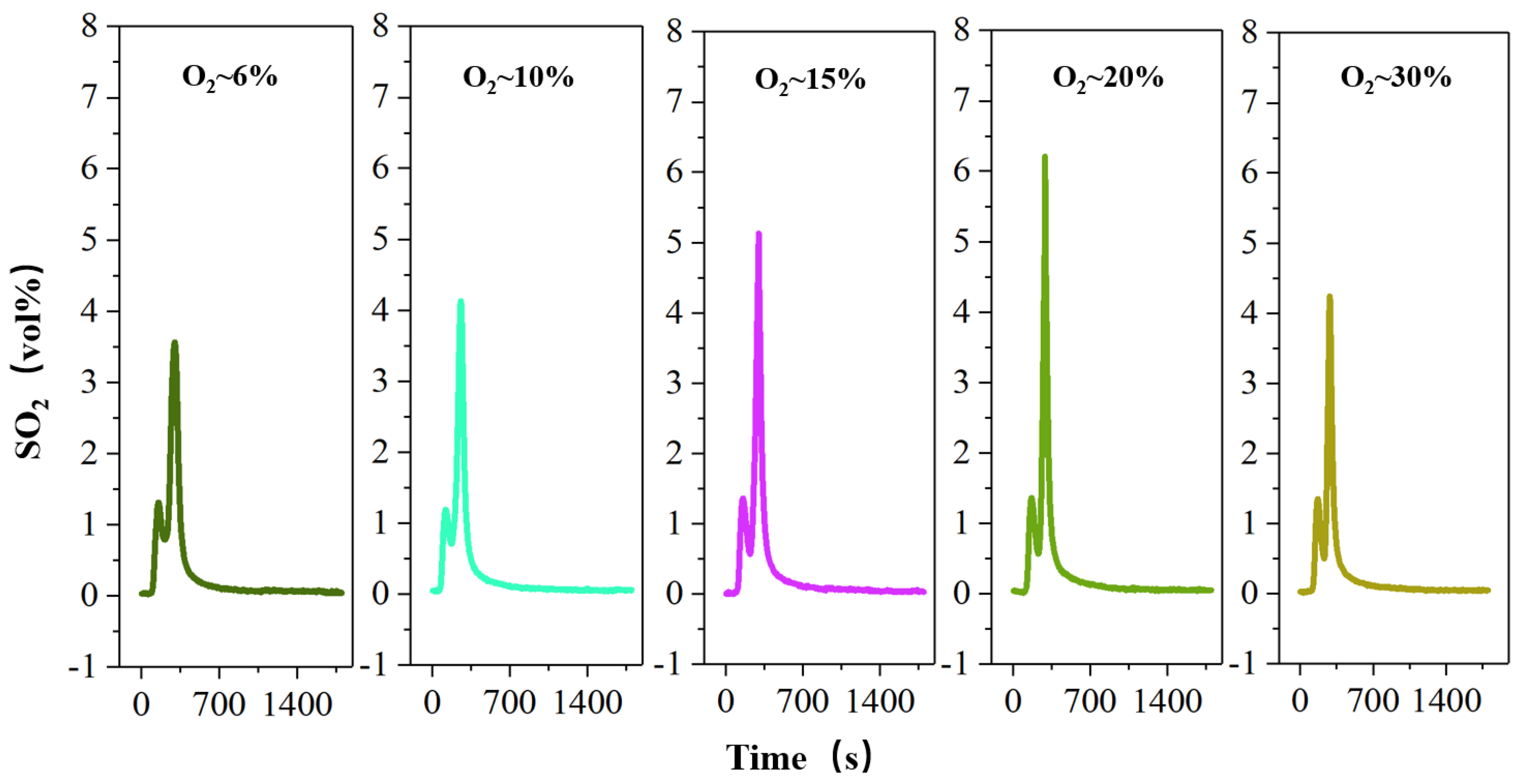
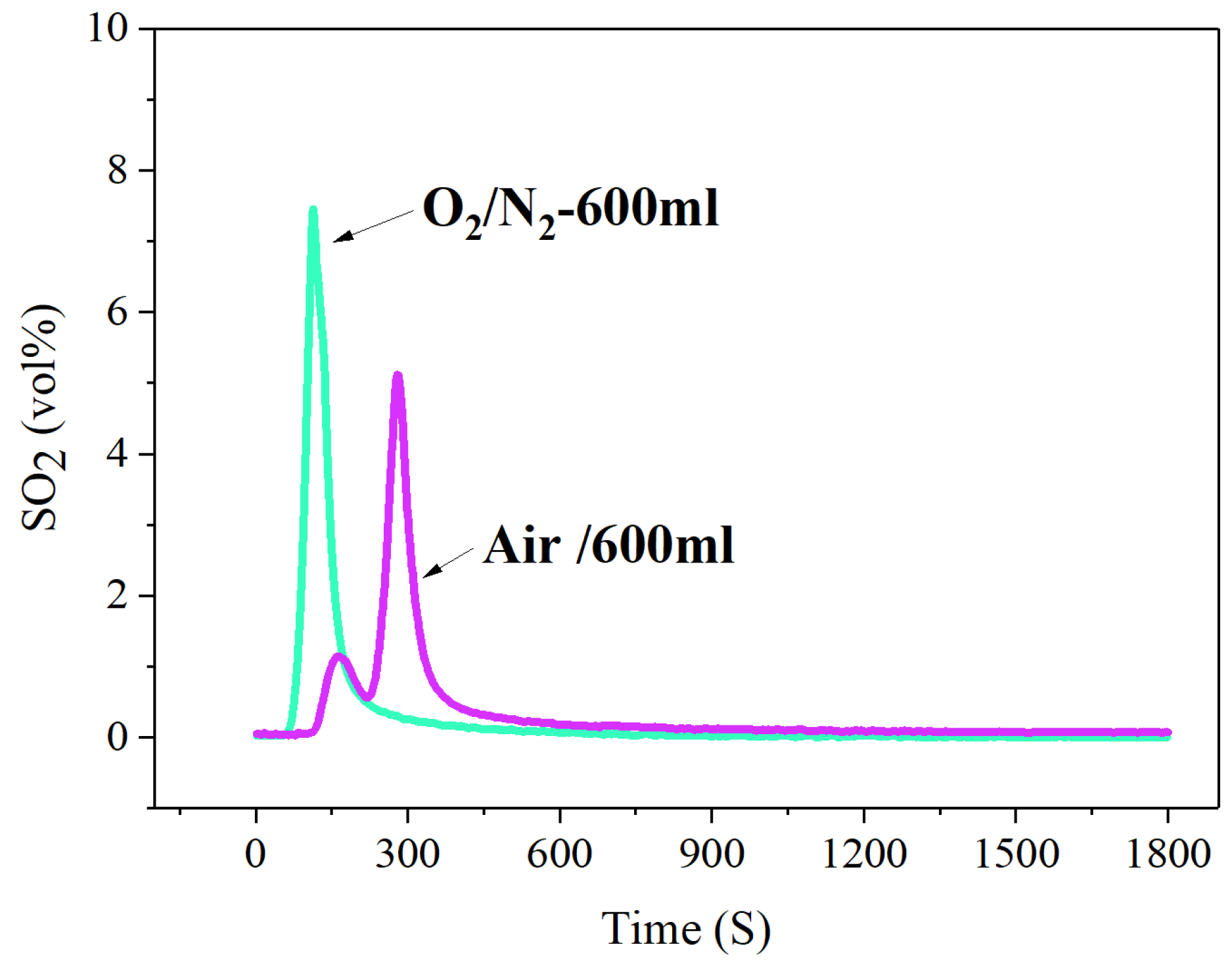

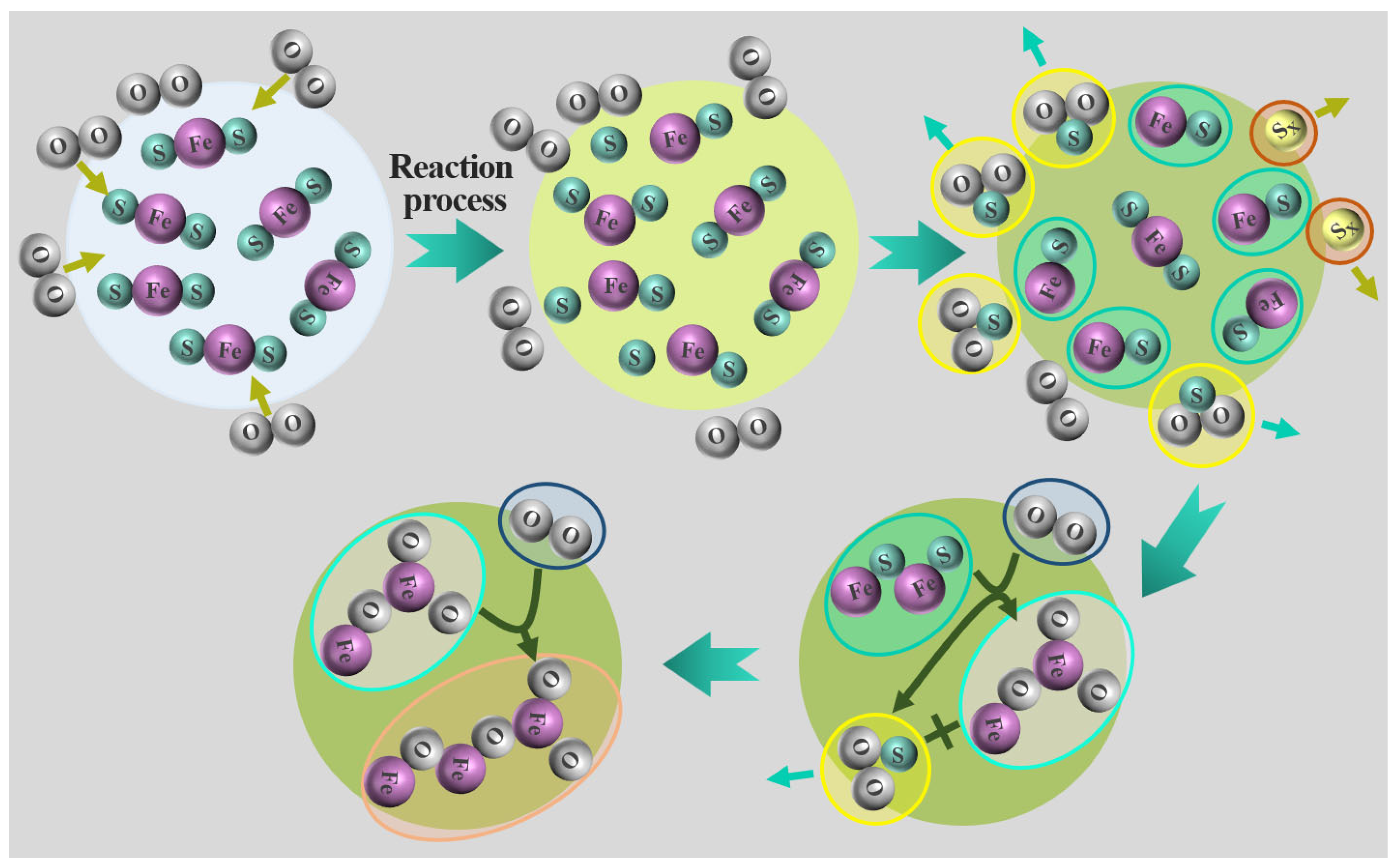


| Composition | S | Fe | SiO2 | MgO |
|---|---|---|---|---|
| Content | 53.60 | 44.42 | 1.00 | 0.68 |
Disclaimer/Publisher’s Note: The statements, opinions and data contained in all publications are solely those of the individual author(s) and contributor(s) and not of MDPI and/or the editor(s). MDPI and/or the editor(s) disclaim responsibility for any injury to people or property resulting from any ideas, methods, instructions or products referred to in the content. |
© 2024 by the authors. Licensee MDPI, Basel, Switzerland. This article is an open access article distributed under the terms and conditions of the Creative Commons Attribution (CC BY) license (https://creativecommons.org/licenses/by/4.0/).
Share and Cite
Chen, X.; Zhao, N.; Li, Z.; Wang, Z. Study on the Migration and Release of Sulfur during the Oxidizing Roasting of High-Sulfur Iron Ore. Minerals 2024, 14, 276. https://doi.org/10.3390/min14030276
Chen X, Zhao N, Li Z, Wang Z. Study on the Migration and Release of Sulfur during the Oxidizing Roasting of High-Sulfur Iron Ore. Minerals. 2024; 14(3):276. https://doi.org/10.3390/min14030276
Chicago/Turabian StyleChen, Xiaojiao, Na Zhao, Zhe Li, and Zijian Wang. 2024. "Study on the Migration and Release of Sulfur during the Oxidizing Roasting of High-Sulfur Iron Ore" Minerals 14, no. 3: 276. https://doi.org/10.3390/min14030276
APA StyleChen, X., Zhao, N., Li, Z., & Wang, Z. (2024). Study on the Migration and Release of Sulfur during the Oxidizing Roasting of High-Sulfur Iron Ore. Minerals, 14(3), 276. https://doi.org/10.3390/min14030276



